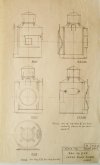Hello Thomas
Without wishing go to deeply into the history side of MR signalling the appointment in 1905 of W.C. Acfield ushered in a new era, with cost savings and new ways of doing things across the Signal Dept.
Dealing with running line signal lamps first.
By the 1890’s a large cylindrical lamp case was fitted to running line signals; a smaller rectangular case being fitted to miniature arm and siding semaphores. Shortly before Acfield’s appointment his predecessor Thomas Woodward had experimented with the new-fangled Adlake long burning signal lamp, an American import and innovation providing a lamp which could burn for over a week without attention - Adlake derives its name from Adams & Westlake of Chicago, a major US manufacturer of lamps. Acfield then commenced to install Adlake lamps across the MR system. Side by side with a MR cylindrical lamp case an Adlake is a very different looking lamp.
Things then get complicated because over time numerous undated versions appeared on the MR and then LMS. By the 1930’s there appears to have been 12 variants in use in the UK, the lamps I understand at some point being manufactured under license in the UK.
Adlake lamps were used by other companies, the Great Central installing them from 1905, but beyond that I don’t have any details.
As you say changes do not happen overnight and photos show this, with the old and the new side by side well into the LMS period and even later.
I don’t know of a dimensioned drawing for any of the Adlake lamps, only photos, and a couple of surviving examples (objects 10711 and 18094-03) which may still be at MSC Derby.
To sum up, even if you choose your post 1906 option cylindrical lamp cases would have still dominated for a considerable period. I would think main lines would have been the first to receive new Adlakes, leaving branch lines, the usual modellers choice, well behind.
Hope the above is of help.
I’ll turn to ground signals in my next post.
Tony

